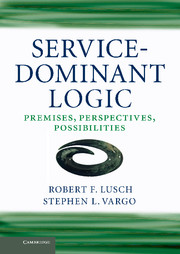Book contents
- Frontmatter
- Dedication
- Contents
- List of Exhibits
- Foreword
- Preface
- Acknowledgments
- Part I Premises
- Part II Perspectives
- 5 It’s all actor-to-actor (A2A)
- 6 The nature, scope, and integration of resources
- 7 Collaboration
- 8 Service ecosystems
- Part III Possibilities
- Appendix Reflection and dialogue
- Index
- References
5 - It’s all actor-to-actor (A2A)
Published online by Cambridge University Press: 05 June 2014
- Frontmatter
- Dedication
- Contents
- List of Exhibits
- Foreword
- Preface
- Acknowledgments
- Part I Premises
- Part II Perspectives
- 5 It’s all actor-to-actor (A2A)
- 6 The nature, scope, and integration of resources
- 7 Collaboration
- 8 Service ecosystems
- Part III Possibilities
- Appendix Reflection and dialogue
- Index
- References
Summary
A state arises, as I conceive, out of the needs of mankind; no one is self-sufficing, but all of us have many wants … Then, as we have many wants, and many persons are needed to supply them, one takes a helper for one purpose and another for another; and when three parties and helpers are gathered together in one habitation, the body of inhabitants is termed a state … And they exchange with one another, and one gives and another receives under the idea that exchange will be for their good.
Plato, The RepublicIntroduction
More than 2,000 years ago, Plato described how actors (e.g., people) rely on one another through the exchange of what service-dominant (S-D) logic refers to as service or applied skills and competences. In the mid-1800s, Bastiat identified this phenomenon as services-for-services exchange and argued that it was the basis for understanding economics and economies. As the globally connected network of actors and communities of actors, including business enterprises, governments, and people, become more pervasive, it is easy to believe that more complicated theories, frameworks, concepts, and models are needed to understand the social and economic world. However, S-D logic, as we argued in Chapter 1, is a more abstract, simpler (but broader), more general, and transcending framework for the understanding of human exchange and exchange systems. In a globally interdependent and interconnected world, the simple truth behind Plato’s words is too often missed: we are all human beings serving each other, through exchange, for mutual well-being.
Viewing actors generically allows the development of a logic of human exchange systems that includes the economy and society and transcends academic disciplines. We argue that it also allows for an academic discipline that has robust, practical application. However, this has not generally been the case for marketing science and theory. Rather, actors are typically identified in terms of discrete roles and functions. Perhaps the most common of these actors is businesses or producers, often abbreviated as “B,” and consumers or customers, often abbreviated as “C.” And this simple division of actors actually constrains, limits, and restricts the robustness of theories and other knowledge frameworks.
- Type
- Chapter
- Information
- Service-Dominant LogicPremises, Perspectives, Possibilities, pp. 101 - 118Publisher: Cambridge University PressPrint publication year: 2014
References
- 1
- Cited by

